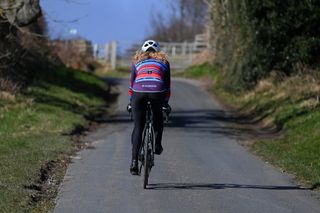Want to go long? Here's how to build your cycling endurance effectively
We spoke to Hunter Allen, co-author of training bible: 𝘛𝘳𝘢𝘪𝘯𝘪𝘯𝘨 𝘢𝘯𝘥 𝘙𝘢𝘤𝘪𝘯𝘨 𝘸𝘪𝘵𝘩 𝘢 𝘗𝘰𝘸𝘦𝘳 𝘔𝘦𝘵𝘦𝘳, on how to grow your engine


The age old, traditional approach to cycling training involves riders building up a layer cake of intensity – starting with a large base of low intensity endurance sponge before perfecting the product with a thick spread of intensity as spring approaches.
This road racer friendly format might not work so effectively for cyclists training for summer endurance events: century long sportives or full days in the mountains at the likes of the Marmotte and Etape du Tour.
If your key goals are around long, endurance events, then it could well be ‘reverse periodisation’ that suits you better as a structure for your cycling training plan.
“This is where you take the intensity relatively high in the winter – December, January, February, even into March if the weather is bad. And then you add in more endurance as the weather changes, when there’s more time to ride outside in the week, and key endurance events are closer,” explains Hunter Allen, the co-author of cyclist's training bible, Training and Racing with a Power Meter.
Allen, founder of Peaks Coaching Group, advocates two very clear session types for those looking to build endurance: long, low intensity rides and medium length rides with tempo intervals. As fitness improves, the two can be converged.
Test yourself out! Enter a sportive with our sister company UK Cycling Events to see how your endurance is coming along, or use them as training rides to clock up the miles. There's events all over the country, and each has a range of distance options - see the calendar here.
How to build your cycling endurance
Long, low intensity rides

“There is a specific endurance training zone,” explains Allen. “If you have a power meter, then it’s 57 to 75 per cent of functional threshold power [FTP], or 68 to 75 per cent of threshold heart rate.”
Get The Leadout Newsletter
The latest race content, interviews, features, reviews and expert buying guides, direct to your inbox!
Thirty minutes at Zone two Endurance won't cut it. These low intensity rides need to be long enough to have any impact.
“Intensity and time are very correlated. For someone who normally rides for an hour, to do a 2.5 hour ride at their endurance zone, that’s going to be enough time to allow them to improve their endurance.
“If they normally do an hour, but just go for 90 minutes, that’s not really going to be enough. Longer is better – three, four and five hour rides will be critical but it’s got to be progressive. You don’t just go out and do five hours if you've not done it before, you need to build up gradually."
It's sometimes suggested that you don't need to complete the full distance of your target event in training, the belief being that on-the-day motivation will carry you through. If the event distance is new to you, Allen isn't a big fan of the approach.
"If you’ve never done the length of time or distance and you’re worried about that, then I want you to do it in training. Mainly just to give you the confidence to know that you can do it.
"If you've done plenty of rides or events of the same length or distance, and know completing it is no big deal, there's no need to worry so much about covering the whole distance in advance."
Tempo rides

Improving endurance isn’t only about going long, though. You can go shorter, and harder.
“We can ride at tempo [sometimes called sweetspot] – which is 76 to 90 per cent of your threshold power, or 75 to 85 per cent of threshold heart rate. Riding there will also improve endurance.
“There is still a time component but we can reduce it. The tempo intervals need to be 30 minutes, or at least two solid blocks of 20 minutes. That additional intensity will be enough to cause adaptations to the cardiovascular system, for your aerobic engine to become more adapted and increase your endurance.”
You can go into the higher zones, but if your true goal is endurance, doing so might not be perfectly tailored.
"You can do blocks of 10 minutes [or more] at FTP", he says, adding that anything shorter than ten minutes is not going to create enough training stress for you to adapt.
"However, the issue with training at FTP is that you might improve on that number, but you may not improve your endurance very much, you might find power really drops off after three hours."
Combining the two

Initially, you’ll want to ride your tempo intervals and long, endurance rides on different days.
“An optimal plan might be two good workouts where you’re riding 60 to 90 minutes of tempo, via a 2x20 or 2x30 or similar. Then on the weekend, pick a day and go out for longer, three to five hours.”
Once you’ve adapted to this, you can begin to build tempo intervals into your long rides, too.
This will both help to boost your overall endurance, and increase your ability to cope with common challenges such as the mountains often nestled into the profile of overseas sportives.
“Some people may have the endurance to ride a 100 mile ride, but they might not have the muscular endurance to do the Etape du Tour, with three or four mountains. It's not only just completing the distance, it’s having the fatigue resistance in your muscles to cope with sustained force for a long period of time.
“That’s the real key: stressing the muscles at a high intensity, incorporated in with a longer ride.”
Allen suggests riders ‘leapfrog’ their way to success with these rides.
“First, get used to riding three hours, then when that’s easy, add in intervals – like two sets of 20 minutes at tempo. Once you can do that, maybe ride four hours and test yourself with one 30 minute block at tempo, then one 45 minute block at tempo. If that’s too hard, go back to just doing four hours of endurance, and come back to the intervals when your fitness improves.
“I call that leapfrogging, back and forth. First, ride the time, then time plus a little bit of intensity, then if you’re still good, keep progressing.”
The cherry on the top is his colloquially named ‘kitchen sink’ workout, listed at the back of the book Training and Racing with a Power Meter. This four to five hour ride contains a host of intervals at varying intensities, before completing the last hour at tempo.
“You’ve pre-fatigued yourself in the first three to four hours, so in the last fourth or fifth hour, you’re really digging deep, that’s a great workout because then you’re trying to give yourself the cardiovascular and muscular stress that will help you get over the mountain in that final hour [of an event],” he says.
Want to give it a go? The technical name is 'Tempo: Aerobic Building, Ride 2' and the intervals are:
- 15 minutes easy riding, 57-75% FTP or 69-83% threshold HR
- 2 x 20 minutes, 10 min rest intervals, at sweetspot, 88-93% FTP or 92 to 98% of threshold HR
- 1hr - cruise but include 4-6 Vo2 intervals of 3 minutes with 3 minute rest, cruise at 80-85% FTP or 85-91% T.HR, Vo2 115% FTP or 105+% T.HR
- 30min-1.5 hour endurance/tempo, 70-85% FTP or 69-75% T.HR
- 15min easy riding, 57-75% FTP or 69-83% threshold HR
Of course, this is one to work towards, and there's more sessions in the book,
Going fasted?

Fasted rides have often been used with the goal of weight loss - because a rider completing an easy zone two ride without topping up their glycogen stores will oxidise (burn) more fat.
Many nutritionists now argue that if that rider refuels with the same quantity of calories, they'll have the same net calorie balance as a person who completed the ride fuelled. In short, fasted rides might teach your body to use fat as fuel, but they won't cause you to lose 'excess' fat or weight.
Fasted rides do set off a process called mitochondrial biogenesis - effectively the creation of new mitochondria in the cells - which in turn boost exercise capacity and thus endurance.
Allen recommends fasted rides only for people who find that they're 'bonking' at the end of long excursions, because training without carbohydrates as fuel will help them to learn how to better access their fat stores when at low intensity. If you're fuelling your training with carbohydrates and having no problems, he suggests leaving fasted rides off the schedule.
"If you're going out and doing four hour plus rides and you’re really struggling with your energy levels at the end, you’re bonking and need to improve your ability to use fat as fuel, I would suggest trying some fasted rides," Allen says advocating hour hours in the saddle, with 2.5 hours ridden on just black coffee and a pit stop to refuel for the last 90 minutes.
"But that’s only if you’re struggling with nutrition in a normal ride," he says, "if you usually feel fine after a long ride, don’t worry about it and ride fuelled."
Find our 10-week long cycling training plan for endurance here.

Thank you for reading 20 articles this month* Join now for unlimited access
Enjoy your first month for just £1 / $1 / €1
*Read 5 free articles per month without a subscription

Join now for unlimited access
Try first month for just £1 / $1 / €1
Michelle Arthurs-Brennan the Editor of Cycling Weekly website. An NCTJ qualified traditional journalist by trade, Michelle began her career working for local newspapers. She's worked within the cycling industry since 2012, and joined the Cycling Weekly team in 2017, having previously been Editor at Total Women's Cycling. Prior to welcoming her daughter in 2022, Michelle raced on the road, track, and in time trials, and still rides as much as she can - albeit a fair proportion indoors, for now.
-
 Tweets of the week: Mark Cavendish's special message, Demi Vollering learns French, and a reindeer enters the wind tunnel
Tweets of the week: Mark Cavendish's special message, Demi Vollering learns French, and a reindeer enters the wind tunnelThe Manx missile has a secret admirer, and you'll never guess who it is
By Tom Davidson Published
-
 Le Col ARC Lightweight Rain Jacket review: light, hooded, waterproof and versatile
Le Col ARC Lightweight Rain Jacket review: light, hooded, waterproof and versatileDesigned for gravel and adventure riding, it features a hood and a host of useful pockets in which to stash snacks and kit
By Andy Turner Published